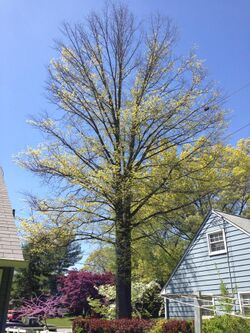Biology:Bacterial leaf scorch
| Bacterial leaf scorch | |
|---|---|
 Large pin oak (Quercus palustris) stricken with bacterial leaf scorch during leaf-out | |
| Common names | BLS |
| Causal agents | Xylella fastidiosa |
| Hosts | trees and crops |
| Vectors | leafhoppers |
Bacterial leaf scorch (commonly abbreviated BLS, also called bacterial leaf spot) is a disease state affecting many crops, caused mainly by the xylem-plugging bacterium Xylella fastidiosa.[1] It can be mistaken for ordinary leaf scorch caused by cultural practices such as over-fertilization.[1]
Hosts
BLS can be found on a wide variety of hosts, ranging from ornamental trees (elm, maple, oak) and shrubs, to crop species including blueberry and almond.[citation needed]
Bacterial spot of peppers and tomatoes
Bacterial spot of peppers and tomatoes is caused by the bacteria Xanthomonas campestris pv. vesicatoria.[citation needed]
Bacterial spot of peaches
Bacterial spot of peaches is caused by the bacteria Xanthomonas campestris pv. pruni. Spots may form on the leaves and they can be mistaken for peach scab, which is caused by a fungus.[citation needed]
Bacterial spot of pecans
Symptoms
An irregular browning leaf margin which may or may not be bordered by a pale halo.[2]
Symptoms re-occur every year, spreading throughout the tree crown, eventually killing the host plant.[2]
Vectors
Xylem-feeding leafhoppers can transmit the disease bacteria.[2]
Treatment
There are no known effective treatments for BLS, consequently, removal of affected plants is recommended.[2]
See also
- Fertilizer burn
- Leaf scorch
References
External links
 |

